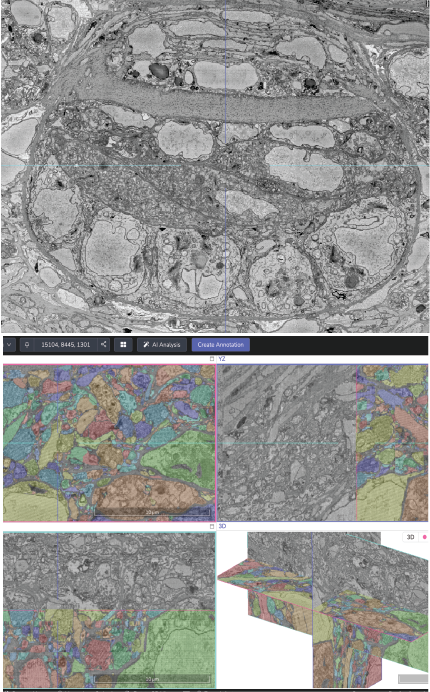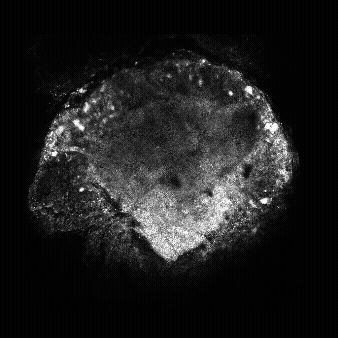The Crook Lab works at multiple levels of organization, from cellular neuroscience to behavior, ecology and evolution.
Our broad focus on the physiology of injury-induced plasticity includes three main areas of research
connectomic, molecular and functional mapping of cephalopod Nervous systems
Large-volume 3d-EM of octopus arm
In this project using the very small octopus O. bocki, we are mapping all the neural elements of the arm and the connections between them. Using a combination of manual and AI-based annotation, we are reconstructing multiple successive arm ganglia and their connections to other peripheral neural elements, as well as blood vessels, musculature and skin chromatic elements.
Connectomics of the sucker ganglion
One of the least studied structures in the octopus arm is the small sucker ganglion, comprising only about 200 neurons. Its small size makes it the only ganglionic structure in the cephalopod currently amenable to complete connectomic reconstruction. We imaged multiple SGs at high resolution and aim to reveal new information about the structure and function of this currently poorly-understood structure. The AI model we are training to automatically segment this tissue will then be applied to a large volume of the axial ganglion neuropil, a highly complex structure that is exceptionally difficult to study.
3D Molecular mapping of the octopus arm nerve cord
In this project we are using HCR to label multiple different transcripts associated with specific neuronal subtypes, and creating large-volume reconstructions from serial sections of the octopus arm nerve cord. Our data so far show areas of regional enrichment of different classes of neurons, as well as many co-expression patterns that have not previously been shown in the arms.
functional Mapping of Cell types and Circuits
A major challenge in cephalopod neuroscience has been to identify how neurons are organized within the nervous system. In this project, we use calcium imaging to identify sensory neurons of different classes and map their organization within the peripheral ganglia. So far we have used this approach to reveal somatotopy in a whole-mount preparation of the stellate ganglion, and we are now imaging in slices to examine sensory neuron organization in the axial ganglia of the arms.
Welfare, Husbandry and Refinement Projects
mechanisms of ANESTHESIA in cephalopods
In this project, we are examining how typical cephalopod anesthetics affect the peripheral and central nervous systems of cephalopods. Using direct recording techniques from the neurons of awake, behaving animals, we can measure how different drugs affect sensation, awareness and memory of cephalopods undergoing noxious or invasive procedures.
The search for functional analgesics for cephalopods
Analgesia in invertebrates is almost completely unstudied, however, its provision is a legal requirement in countries that regulate the use of cephalopods in research. We are using behavioral and cognitive assays to measure the effects of common analgesics with highly conserved molecular targets on cephalopods, and neural recordings to look at effects on the peripheral and central nervous systems.
The Neurobiology of senescence in cephalopods
Cephalopods in research institutions and public aquaria often live extended lives due to lack of breeding opportunity and predation risk. The end-of-life senescent period is characterized by skin and tissue degradation and cognitive decline. In this project we are using tissue sampled from Giant Pacific Octopuses (Enteroctopus dofleini) to identify nervous system degeneration that may affect sensation, perception and welfare at end-of-life.
Assessing welfare through cognitive/Affective assays
Cephalopod welfare is a topic of growing importance and interest. In a series of related studies, we adapt validated procedures from mammalian neuroscience to assess welfare, stress and potential suffering in cephalopods. These studies are designed to objectively identify, test and evaluate interventions that optimize the welfare of laboratory cephalopods. These studies use CPP, cognitive bias tasks and motivational tradeoff assays, all of which are considered strong indicators of affective state in mammals.
Mechanisms and functions of Injury-induced plasticity
Effects of early-life injury on long-term neural plasticity
In mammals, injury experienced in early life can result in life-long increase in pain sensitivity. Using squid and octopus, we are testing the hypothesis that this is a highly conserved mechanism that allows animals to adapt to a persistently dangerous environment, where costs of permanent hypersensititvy are outweighed by the benefits of long-term plasticity in nociceptive sensory circuits.
Effects of Tissue injury on camouflage choice and quality
Octopuses are renowned for their exceptional ability to match their substrate, however, injury can create white patches where chromatic skin has been removed. In this project, we are looking at how octopuses with minor injuries evaluate their camouflage options, and determining whether visual, nociceptive or combinations of cues underlie injury-induced changes to optimal camouflage decision-making.
Plasticity in the escape Jet circuit
Squid escape from danger by jetting backwards rapidly; a series of giant nerve fibers controls this action. Despite extensive study of the giant axon and synapse of the squid, little is known about its role in natural function. In this project, we ask how injury affects jet escape threshold, and whether the giant axon and synapse are the source of this plasticity.
Effects of ANTHROPOGENIC disturbance on adaptive, injury-induced behaviors
Climate change and marine pollutants have wide ranging effects on coastal animals’ physiology. In a series of related projects, we are looking at how stress from various anthropogenic disturbances affect animals’ abilities to cope with injury, a prevalent and evolutionarily ancient stressor. Using behavioral and neurophysiological assays, we are looking at how EDCs and elevated temperatures affect animals after injury.
CENTRAL NERVOUS SYSTEM PLASTICITY AFTER PERIPHERAL INJURY
The cephalopod CNS is the most complex invertebrate brain, but it is poorly characterized. In this study, we are examining the properties of sensory neuron cell bodies in the central brain, and measuring changes in excitability in cells and circuits in the higher cognitive centers in the supraesophageal ganglion.
ROLE OF THE STELLATE GANGLION IN MODULATING NOCICEPTIVE SENSITIZATION
The stellate ganglion contains the giant synapse that mediates escape jetting, but also contains many other cell bodies. In this study we look at how the stellate ganglion modulates excitability in the peripheral nervous system, by measuring excitability in nerves central and peripheral to the stellate ganglion.
This is a selection of projects in various stages. For more information, contact the lab.
Potential students who wish to work on a specific project or a project of their own design should speak with Dr. Crook, for further information regarding availability, feasibility and funding.














